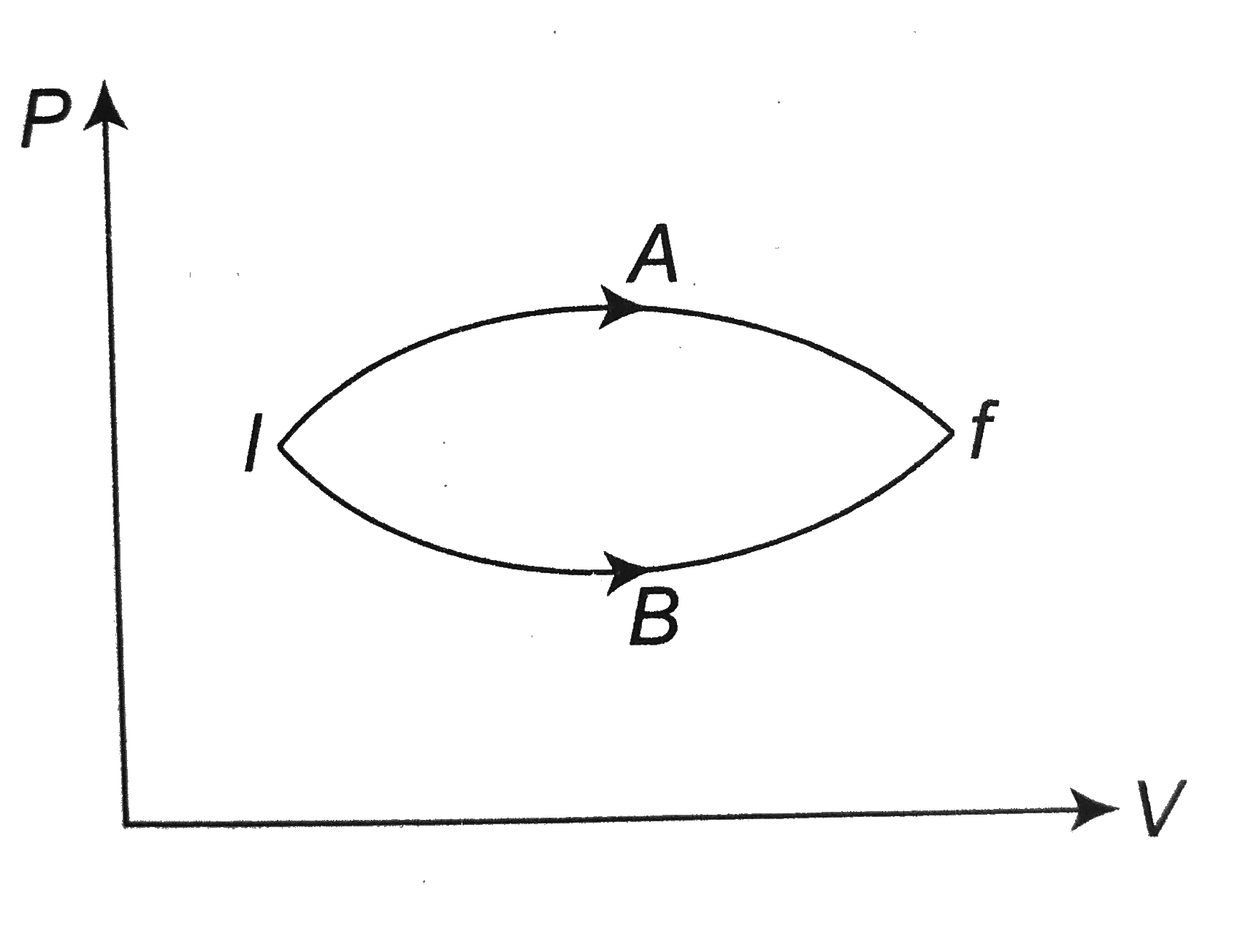A thermodynamic system is taken from an initial state i with internal energy Ui=100J to the final state f along two different paths iaf and ibf, as schematically shown in the figure. The work done by the system along in the paths af, ib and bf are Waf=200J,Wjb=50J and Wbf=100J respectively. The heat supplied to the system along the path jaf, jb and are Qjaf,Qjb and Qbf respectively. If the internal energy of the system in the state b is Ub=200J and QJaf=500J, the ratio Qbf/Qjb is.

The correct Answer is:2
Qiaf=Wiaf+ΔUiaf
500=200+ΔUiaf
Uiaf=300
Uf=400
Qfb=Wfb+ΔUfb
=50+100
Qib=150
Qbf=Wbf+ΔUbf
=100+200
Qbf=300
QbfQfb=300150=2 ans
Topper's Solved these Questions
- GEOMETRICAL OPTICSBOOK - ALLENCHAPTER - GEOMETRICAL OPTICSEXERCISE - EXERCISE - 05 (B) (MCQ)
9 Videos
- GEOMETRICAL OPTICSBOOK - ALLENCHAPTER - GEOMETRICAL OPTICSEXERCISE - EXERCISE - 05 (B) (MATCH THE COLUMN)
3 Videos
- GEOMETRICAL OPTICSBOOK - ALLENCHAPTER - GEOMETRICAL OPTICSEXERCISE - EXERCISE - 05 (A)
73 Videos
- CURRENT ELECTRICITYBOOK - ALLENCHAPTER - CURRENT ELECTRICITYEXERCISE - EX.II
66 Videos
- GRAVITATIONBOOK - ALLENCHAPTER - GRAVITATIONEXERCISE - EXERCISE 4
9 Videos
Similar Questions
A thermodynamic system is taken from an initial state I with internal energy Ui=−100J to the final state f along two different paths iaf and ibf, as schematically shown in the figure. The work done by the system along the pat af, ib and bf are Waf=200J,Wib=50JandWbf=100J respectively. The heat supplied to the system along the path iaf, ib and bf are Qiaf,Qib,Qbf respectively. If the internal energy of the system in the state b is Ub=200JandQiaf=500J, The ratio QbfQib is

View SolutionIn the above question, if the work done on the system along the curved path 'ba' is 52J, heta abosrbed is
View Solution
Knowledge Check
A system goes from A to B by two different paths in the P-V diagram as shown in figure Heat given to the system in path 1 is 1100 j, the work done by the system along path 1 is more than path 2 by 150 J. The heat exchanged by the system in path 2 is
 A800 JB750 JC1050 JD950 J
A800 JB750 JC1050 JD950 J
A system has internal energy U1. If 500 J of heat is supplied to it and at the same time it does 300 J of work. Calculate the internal energy of the system in the new state,
View SolutionIn the figure given two processes AandB are shown by which a thermodynamic system goes from initial state I to final state F. if ΔQA and ΔQB are respectively the heats supplied to the systems then

View SolutionWhen a system is taken from state i to state f along the path iaf, it is found that Q=50calandW=20cal. Along the path ibf Q=36cal. W along the path ibf is

View SolutionWhen a system is taken from state i to state f along the path iaf, it is found that Q=50calandW=20cal. Along the path ibf Q=36cal. W along the path ibf is

View SolutionFor a gaseous state if heat supplied to the system is 100 J and work done by the system is 25 J. then internal energy of the system is
View SolutionA system goes from P to Q by two different paths in the p−V diagram as shown in figure. Heat given to the system in path 1 is 1000 J. The work done by the system along path 1 is more than path 2 by 100 J. What is the heat exchanged by the system in path 2 ?

View SolutionWhen a thermodynamic system is taken from an initial state I to a final state F along the path IAF, as shown in Fig. the heat energy absorbed by the system is Q=55J and work done by the system is W=25J. If the same system is taken along the path IBF, the value of Q=35J.
(a) If W=−15J for the curved path FI, how much heat energy is lost by the system along this path ?
(b) If U1=10J, what is UF ?
(d) If UB=20J, what is Q for the process BF and IB ?
View Solution
